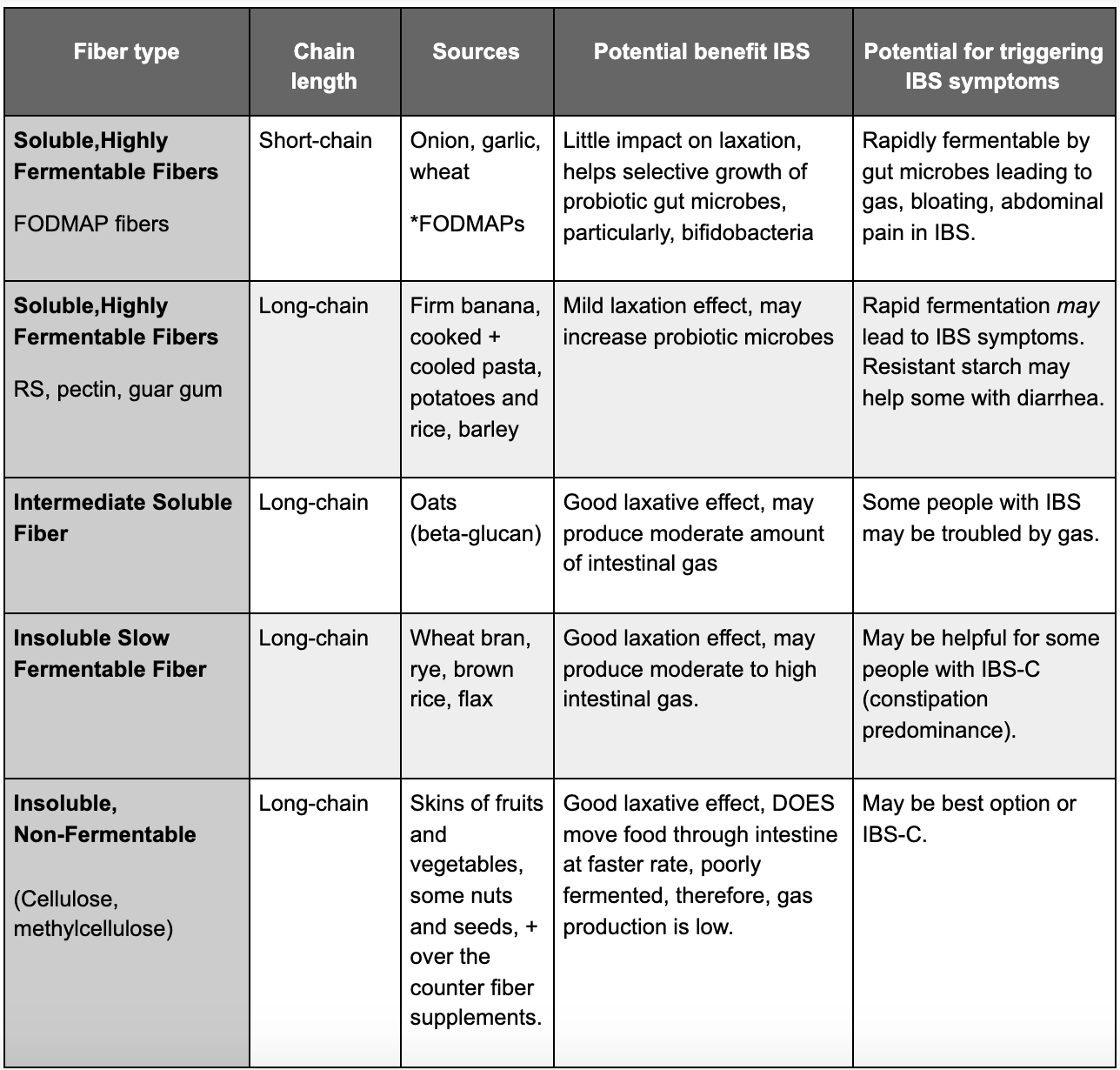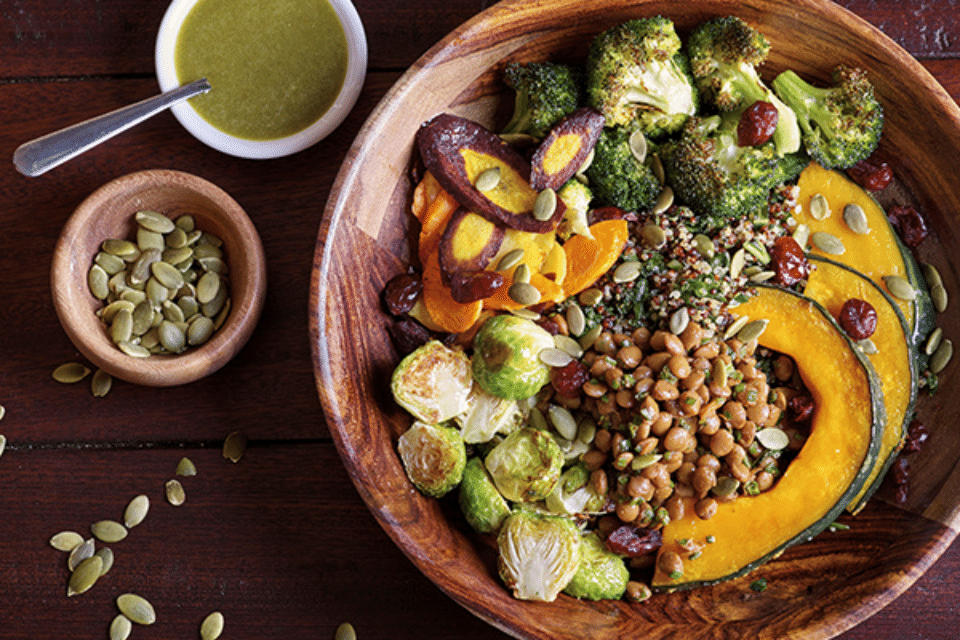What is dietary fiber and how much do you need?
As a general rule, the term dietary “fiber” pertains to the non-digestible portion of plant-based carbohydrates. High-fiber foods include fruits, vegetables, whole grains, beans, nuts, and seeds. Eating enough dietary fiber promotes health benefits like gut health, lower blood sugar, contributes to satiety and weight loss, and is also associated with a lower risk of colon cancer, heart disease, and diabetes. The National Academy of Sciences Institute of America recommends that adult women have an intake of about 21-26 grams and men 30-38 grams of dietary fiber per day. The typical American falls quite short on fiber intake, with an average of about 15 grams of dietary fiber for women and 18 grams of dietary fiber for men.(SOURCE: What We Eat in America, NHANES 2009-2010, day 1, individuals 2+ years)
Gut health and dietary fiber
Different types of fiber intake from various food sources and fiber supplements have been utilized as a part of the treatment plan for many digestive conditions such as diarrhea, constipation, irritable bowel syndrome, and inflammatory bowel disease. Fiber is an “umbrella term,” meaning that it encompasses many different types of fibers, including both soluble fiber and insoluble fiber. Fibers can vary in their:
- Solubility (Some fibers are water-soluble, meaning they can mix with water, while others are insoluble in water.)
- Chain length (Some fibers are very long and some are short; some FODMAP carbohydrates are short-chain fibers.)
- Viscosity (Viscous fibers form a gel-like substance, like chia seeds or psyllium husk, and this effect appears to aid their ability to help with laxation, lowering of blood fats and blood sugar, as well as weight loss.)
High-fiber food sources can contain more than one type of dietary fiber. The skin of an apple is rich in insoluble fiber while the flesh inside is rich in soluble fiber. Moreover, oats contain beta-glucans, a viscous, soluble fiber as well as resistant starch (especially in uncooked oats, such as in energy bites), and insoluble fiber too. Resistant starch (RS) is a long chain fiber that can feed our probiotic gut microbes, which has many health benefits. RS is not a FODMAP fiber source as it is a very long fiber. Remember, FODMAPs are short-chain fibers that gut microbes ferment rapidly. FODMAP fibers are like “fast food” for our gut microbes.
This table describes different types of dietary fibers, their chain length, and their potential role in IBS.

Table adapted from: Eswaran S, Muir J, Chey WD. Fiber and functional gastrointestinal disorders. Am J Gastroenterol. 2013;108(5):718-727.
Getting enough fiber on the low FODMAP diet
There are many fiber-rich food sources that are compatible with the low FODMAP diet, including strawberries, carrots, kiwifruit, quinoa, oats, chia seeds, and flax seeds, to name a few.
Click below to download our all-new dietary fiber handout for more detailed information about fiber-rich foods and their health benefits on the low FODMAP diet.
{{cta(‘34304e77-945f-4cb3-8688-e65ea2698efd’)}}
A fiber-rich low FODMAP daily menu example:
Total daily fiber = 29 grams
A delicious and convenient way to up your fiber is with Epicured’s nourishing salads!
These freshly made and ready to eat dishes can be delivered right to your doorstep! View our menu.

Here are 10 easy tips to help you meet your fiber needs while managing your IBS symptoms.
Fiber is a nutrient that some people following the low FODMAP diet fall short on.
- Increase fiber intake slowly. Expect some changes in intestinal gas and bloating as your gut adapts.
- Try to obtain fiber from food vs. supplements, when possible. Plant foods contains fiber plus vitamins, minerals, and antioxidants with extra health benefits.
- Fiber is not a one-size fits all nutrient. Your tolerance will vary depending on how sensitive the gut is as well as what microbes reside in the intestine.
- Drink adequate water as you increase fiber intake. Water helps the fiber work its magic.
- Add low FODMAP fiber seeds for a fiber boost–1 tablespoon of chia seeds provides 4-5 grams of low FODMAP fiber.
- Try adding small amounts of uncooked oats to your diet to increase resistant starch intake, a prebiotic fiber. This energy bite recipe is a great way to boost resistant starch.
- Spread your fiber intake out over the day–don’t try to obtain your daily quota in one meal. Fiber is filling and too much fiber at one meal can make you feel over-full and bloated.
- Try not to be a creature of habit. Get your fiber from different food sources! Eating 30 different plants per week is associated with a greater diversity of microbes in your gut, a potential marker of better gut health.
- Remember to do all 3 phases of the low FODMAP diet to help identify what foods are triggering your GI distress and which ones are not! Once you have identified foods you can tolerate–be sure to add them back to help diversity your fiber intake. The FODMAP subtype, oligosaccharides includes galacto-oliogosaccharides (sources: beans, cashew nuts) and fructans (sources: onion, garlic wheat). These are well-known prebiotics. This means they feed health-promoting gut microbes. Add back oligosaccharides if you tolerate them.
- Working with a dietitian can be helpful to provide personalized advice and steps to adding more fiber to your diet. Find a FODMAP knowledgeable dietitian here.


